2015 TB145
2015 TB145 is a sub-kilometer asteroid, classified as near-Earth object and potentially hazardous asteroid of the Apollo group, approximately 650 meters (2,000 feet) in diameter.[3] It safely passed 1.27 lunar distances from Earth on 31 October 2015 at 17:01 UTC,[7] and passed by Earth again in November 2018.
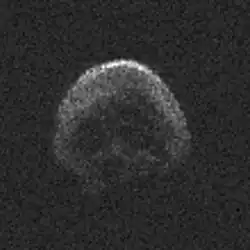 Radar image of 2015 TB145 taken by the Arecibo Observatory on 30 October 2015. | |
| Discovery[1] | |
|---|---|
| Discovered by | Pan-STARRS |
| Discovery date | 10 October 2015 |
| Designations | |
| 2015 TB145 | |
| Orbital characteristics[2] | |
| Epoch 31 May 2020 (JD 2459000.5) | |
| Uncertainty parameter 0 | |
| Observation arc | 3.11 yr (1,137 d) |
| Aphelion | 3.9073 AU |
| Perihelion | 0.2941 AU |
| 2.1007 AU | |
| Eccentricity | 0.86002 |
| 3.04 yr (1,112.1 d) | |
| 121.744° | |
| 0° 19m 25.364s / day | |
| Inclination | 39.6899° |
| 37.698° | |
| 121.744° | |
| Earth MOID | 0.00295731 AU (442,407 km) |
| Jupiter MOID | 2.41052 AU |
| TJupiter | 2.97 |
| Physical characteristics | |
| Dimensions | |
| 0.06[5] | |
| 20.0[2][6] | |
Discovery
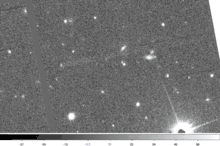
The asteroid was first observed on 10 October 2015 by Pan-STARRS at an apparent magnitude of 20 using a 1.8-meter (71 in) Ritchey–Chrétien telescope.[1][6][lower-alpha 1] The asteroid was not discovered sooner because it spends most of its time beyond the orbit of Mars, has a large orbital inclination, and is usually well below the plane of the ecliptic.[9] The asteroid last passed within 0.064 AU (9,600,000 km; 5,900,000 mi) of Earth on 29 October 1923 and will not pass that close again until 1 November 2088.[7]
The media has nicknamed the asteroid the "Great Pumpkin"[10] after the animated Halloween television special It's the Great Pumpkin, Charlie Brown,[11] "Spooky",[12] the "Halloween Asteroid",[13][14] and the "Skull Asteroid"[11] due to its skull-like appearance following radio frequency images taken at Arecibo Observatory and closest approach coincidentally occurring on Halloween day.[11]
2015 flyby
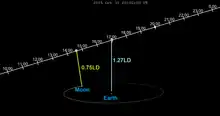
On 31 October 2015 the asteroid passed 0.00191 AU (286,000 km; 178,000 mi) from the Moon and then passed 0.00325 AU (486,000 km; 302,000 mi) from Earth.[7]
The last approach this close by an object with absolute magnitude brighter than 20 was 2004 XP14 on 3 July 2006 at 1.1 lunar distances. The next object this large known to pass this close to Earth is (137108) 1999 AN10 that will pass about 1 lunar distance from Earth on 7 August 2027.[15] It is estimated that there are about 2400 near-Earth asteroids 300–500 meters in diameter, of which about 1100 have been discovered.[16]
During closest approach to Earth the asteroid reached about apparent magnitude 10,[17] which is much too faint to be seen by the naked eye. Even at peak brightness, the asteroid was a challenging target for amateur astronomers with small telescopes, best seen in the Northern hemisphere. The glare from an 80% waning gibbous Moon also hindered observations.
At 11:00 UT the asteroid was in the constellation of Taurus about 9 degrees from the Moon and moving at a rate of 3.4 degrees per hour.[17] At the time of closest approach of 17:00 UT the asteroid was in the constellation of Ursa Major about 56 degrees from the Moon and moving at a rate of 14.7 degrees per hour.[17] After closest approach it quickly became too faint and too close to the Sun in the sky to be seen.[15]
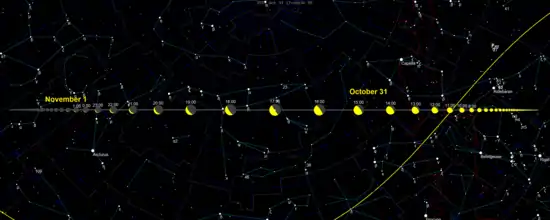
| PHA | Date | Approach distance in lunar distances | Abs. mag (H) |
Diameter (C) (m) |
Ref (D) | ||
|---|---|---|---|---|---|---|---|
| Nominal(B) | Minimum | Maximum | |||||
| (152680) 1998 KJ9 | 1914-12-31 | 0.606 | 0.604 | 0.608 | 19.4 | 279–900 | data |
| (458732) 2011 MD5 | 1918-09-17 | 0.911 | 0.909 | 0.913 | 17.9 | 556–1795 | data |
| (163132) 2002 CU11 | 1925-08-30 | 0.903 | 0.901 | 0.905 | 18.5 | 443–477 | data |
| 69230 Hermes | 1937-10-30 | 1.926 | 1.926 | 1.927 | 17.5 | 700-900[18] | data |
| 69230 Hermes | 1942-04-26 | 1.651 | 1.651 | 1.651 | 17.5 | 700-900[18] | data |
| 2017 NM6 | 1959-07-12 | 1.89 | 1.846 | 1.934 | 18.8 | 580–1300 | data |
| (27002) 1998 DV9 | 1975-01-31 | 1.762 | 1.761 | 1.762 | 18.1 | 507–1637 | data |
| 2002 NY40 | 2002-08-18 | 1.371 | 1.371 | 1.371 | 19.0 | 335–1082 | data |
| 2004 XP14 | 2006-07-03 | 1.125 | 1.125 | 1.125 | 19.3 | 292–942 | data |
| 2015 TB145 | 2015-10-31 | 1.266 | 1.266 | 1.266 | 20.0 | 620-690 | data |
| (137108) 1999 AN10 | 2027-08-07 | 1.014 | 1.010 | 1.019 | 17.9 | 556–1793 | data |
| (153814) 2001 WN5 | 2028-06-26 | 0.647 | 0.647 | 0.647 | 18.2 | 921–943 | data |
| 99942 Apophis | 2029-04-13 | 0.0981 | 0.0963 | 0.1000 | 19.7 | 310–340 | data |
| 2017 MB1 | 2072-07-26 | 1.216 | 1.215 | 2.759 | 18.8 | 367–1186 | data |
| 2011 SM68 | 2072-10-17 | 1.875 | 1.865 | 1.886 | 19.6 | 254–820 | data |
| (163132) 2002 CU11 | 2080-08-31 | 1.655 | 1.654 | 1.656 | 18.5 | 443–477 | data |
| (416801) 1998 MZ | 2116-11-26 | 1.068 | 1.068 | 1.069 | 19.2 | 305–986 | data |
| (153201) 2000 WO107 | 2140-12-01 | 0.634 | 0.631 | 0.637 | 19.3 | 427–593 | data |
| (276033) 2002 AJ129 | 2172-02-08 | 1.783 | 1.775 | 1.792 | 18.7 | 385–1242 | data |
| (290772) 2005 VC | 2198-05-05 | 1.951 | 1.791 | 2.134 | 17.6 | 638–2061 | data |
| (A) This list includes near-Earth approaches of less than 2 lunar distances (LD) of objects with H brighter than 20. (B) Nominal geocentric distance from the center of Earth to the center of the object (Earth has a radius of approximately 6,400 km). (C) Diameter: estimated, theoretical mean-diameter based on H and albedo range between X and Y. (D) Reference: data source from the JPL SBDB, with AU converted into LD (1 AU≈390 LD) (E) Color codes: unobserved at close approach observed during close approach upcoming approaches | |||||||
2018 flyby

After it had been unobservable for almost three years, 2015 TB145 was recovered on 7 October 2018 by L. Buzzi at Schiaparelli Observatory (observatory code 204), at apparent magnitude 21.[19]
The 11 November 2018 flyby was about 0.267 AU (39,900,000 km; 24,800,000 mi) from Earth.[7][20]
Observations
Radar imagery
The close approach was studied with radar using Goldstone, the Green Bank Telescope,[15] and the Arecibo Observatory. It was one of the best radar targets of the year with a resolution as high as 2 meters (7 ft) per pixel.[15] Bistatic radar images created with the Green Bank Telescope had a resolution of 4 meters (13 ft) per pixel.[21] Arecibo images had a resolution of 7.5 meters (25 ft) per pixel.[5]
| 30 October | 31 October 12:55–13:08 UTC |
1 November |
|---|---|---|
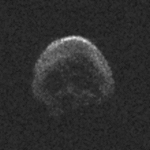 |
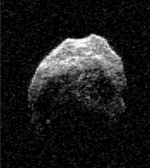 |
Possible cometary origin
The high orbital inclination and eccentricity suggest 2015 TB145 may be an extinct comet that has shed its volatiles after numerous passes around the Sun.[5][22] Orbital calculations by Petrus Jenniskens and Jérémie Vaubaillon showed that it was not expected to produce associated meteors in 2015.[23] Any meteoroids were expected to pass more than 0.0007 AU (100,000 km; 65,000 mi) from Earth's orbit.[23]
If meteoroids related to this asteroid were to cross Earth's path, the radiant is expected to be near Northern Eridanus.[23] Cameras for Allsky Meteor Surveillance (CAMS) did not detect any activity in the presumed area of the sky during 2013 and 2014.[23] The object has a low albedo of 0.06, which is only slightly more than a typical comet that has an albedo of 0.03-0.05.[5]
Notes
- For comparison, around 6 October 2012, the asteroid peaked at about apparent magnitude 20.9, but had a solar elongation of only about 75 degrees while 0.4 AU from Earth.[8]
References
- "MPEC 2015-T86: 2015 TB145". IAU Minor Planet Center. 13 October 2015. Retrieved 14 October 2015. (K15TE5B)
- "JPL Small-Body Database Browser: (2015 TB145)" (2018-11-20 last obs.). Jet Propulsion Laboratory. Retrieved 1 March 2020.
- Müller, T. G.; Marciniak, A.; Butkiewicz-Bąk, M.; Duffard, R.; Oszkiewicz, D.; Käufl, H. U.; Szakáts, R.; Santana-Ros, T.; Kiss, C.; Santos-Sanz, P. (February 2017). "Large Halloween asteroid at lunar distance" (PDF). Astronomy & Astrophysics. 598: A63. arXiv:1610.08267. Bibcode:2017A&A...598A..63M. doi:10.1051/0004-6361/201629584. S2CID 119162848. Retrieved 13 October 2018.
- "Asteroid Size Estimator". CNEOS NASA/JPL. Retrieved 16 February 2018.
- Halloween Skies to Include Dead Comet Flyby. NASA-JPL press release. 30 October 2015
- "2015 TB145 Orbit". IAU Minor Planet Center. Retrieved 24 January 2016.
- "JPL Close-Approach Data: (2015 TB145)" (last observation: 2015-10-27; arc: 17 days). Retrieved 22 October 2015.
- "2015TB145 Ephemerides for October 2012". NEODyS (Near Earth Objects – Dynamic Site). Retrieved 24 October 2015.
- Kelly Beatty (22 October 2015). "Close-in Asteroid Offers Halloween Treat". Sky & Telescope. Retrieved 26 October 2015.
- Sarah Begley (30 October 2015). "NASA Says 'Great Pumpkin' Asteroid Will Fly by on Halloween". TIME Magazine.
- Nick Divito (31 October 2015). "Spooky 'skull asteroid' whizzes past Earth on Halloween". New York Post.
- Andrew Fazekas (23 October 2015). "Asteroid Called 'Spooky' Will Buzz Earth on Halloween". National Geographic Society.
- Koren, Marina (31 October 2015). "A Halloween Comet". The Atlantic. Retrieved 1 January 2019.
- ESA (28 October 2015). "Halloween Asteroid Gives us a Miss, Confirms ESA". European Space Agency. Archived from the original on 4 May 2017. Retrieved 2 November 2015.
- Lance A. M. Benner (24 October 2015). "Goldstone Radar Observations Planning: 2009 FD and 2015 TB145". NASA/JPL Asteroid Radar Research. Retrieved 24 October 2015.
- "WISE Revises Numbers of Asteroids Near Earth". NASA/JPL. 29 September 2011. Retrieved 29 October 2015. (NASA Space Telescope Finds Fewer Asteroids Near Earth)
- "2015TB145 Ephemerides for 15 October 2015 through 31 October 2015". NEODyS (Near Earth Objects – Dynamic Site). Retrieved 14 October 2015.
- Marchis, F.; et al. "Multiple asteroid systems: Dimensions and thermal properties from Spitzer Space Telescope and ground-based observations". Icarus. 221 (2): 1130–1161. Bibcode:2012Icar..221.1130M. doi:10.1016/j.icarus.2012.09.013. Retrieved 24 August 2018.
- "MPEC 2018-T130: 2015 TB145". Minor Planet Center. 10 October 2018. Retrieved 13 October 2018.
- Williams, Matt (1 October 2018). "The "Death Comet" Will Pass By Earth Just After Halloween". Universe Today. Retrieved 13 October 2018.
- "PIA20043: Halloween Asteroid Rotation". NASA/JPL-Caltech/GSSR/NRAO/GB. 3 November 2015. Retrieved 4 November 2015.
- Agle, D. C. (21 October 2015). "NASA Spots the 'Great Pumpkin': Halloween Asteroid a Treat for Radar Astronomers". NASA News. Retrieved 26 October 2015.
- "Possible October 31 Meteors From Minor Planet 2015 TB_145". SETI Institute. 26 October 2015. Archived from the original on 28 October 2015. Retrieved 26 October 2015. (CBET 4154)
External links
- ALERT! Bright NEO 2015 TB145 on 29–31 October 2015 – Ian Musgrave (itelescope)
- WebCite archive of JPL solution #2 from 14 October 2015
- Halloween Asteroid is a Radar Science Treat (NASA Jet Propulsion Laboratory on YouTube)
- Halloween Asteroid 2015 TB145 Flyby Jerry Hilburn, 10/31/2015 12:12-12:24AM, Catfish Observatory, Teirra Del Sol, Canon 5D and an Orion ED 80 Refractor on an AVX Celestron Mount
- 2015 TB145 at NeoDyS-2, Near Earth Objects—Dynamic Site
- 2015 TB145 at ESA–space situational awareness
- 2015 TB145 at the JPL Small-Body Database


